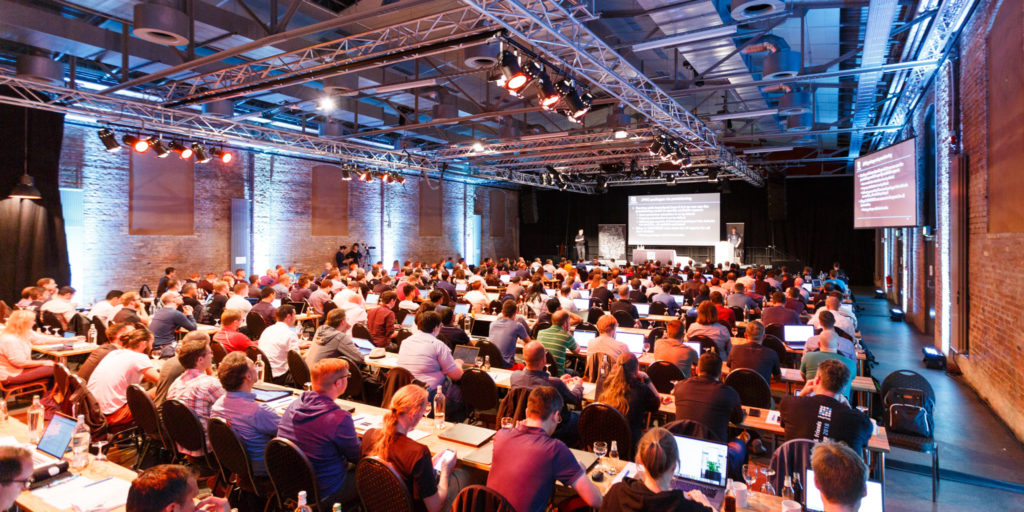adaptTo () is a technical conference, focused around Apache Sling and its technologies.
The technologies themselves may seem a bit exotic for people who create the J2EE application every day, but it is worth mentioning that they are part of the technological stack of Adobe Adobe Experience Manager – AEM. Certainly, this fact, to a large extent, contributed to the popularity of the entire conference – when one of the speakers asked who hadn’t experienced Adobe AEM at all, fewer than 10% of participants raised their hands. The conference was sponsored by PROVISION and ADOBE. It was the third one and largest in scale.
It is impossible to remain indifferent when passing by the place that the organizers of adaptTo () chose this year. Taking into account the conferences we’ve been to before, KulturBrauerei – Palais is the most beautiful building we have ever had the pleasure of staying at. The amazing, industrial atmosphere perfectly fits into the “geek rally”, and the disco ball hanging above the heads is quite a funny contrast to the rather serious, technical tone of the presentation.
The conference lasted three days (September 23 – September 25) and nearly 20 lectures on various topics were presented – those directly related to Apache Sling, but also dedicated to Adobe AEM. The first day was primarily the presentation of Apache Sling. A good move on the part of the organizers was the preparation of “Rookie-Session: JCR & Sling” – although the basics of technology were shown, the lecture was very valuable in terms of content- it allowed to systematize knowledge and supplement the identified deficiencies.
The next session, namely “Keynote: Apache Sling Changes”, provided a lot of information related to the planned and introduced changes in Apache Sling. “A lot is happening” – I think that this sentence describes in a good way the situation of Adobe Sling technology – no doubt, Adobe AEM fuels it and makes it more and more popular.
The next presentation also concerned changes in the technology related to Adobe Sling – Apache Oak (Jackrabbit). Similarly to the previous case – “there is a lot going on”. One could say “more than a lot”. Adobe AEM is not afraid of major changes and invests in new technologies, thus facilitating their development.
Another presentation, by Tomasz Rękawka from Cognifide, was one of the most interesting. Tomek presented the possibility of integration of the JMS queue (ActiveMQ) with Apache Sling in order to enable the exchange of messages between different instances. Examples were presented, which strongly support the effectiveness of the proposed solution. A big plus for Cognifide for sharing source codes and providing help, if necessary.
The last but one of the presentations of the first day was devoted to the possibility of using Varnish Cache in Adobe AEM projects. In the case of such presentations / solutions, the numbers speak for their quality. We were not disappointed – Varnish enabled 50x performance increase (decrease of loading time)
The second day was also full of interesting speeches. We chose a few that we think are worth special attention.
The first of the presentations is “Scaling Search in Oak with Solr”, which shows how you can integrate Apache Solr with Oak (hence, also with Adobe AEM). A lot of cases and examples of use can be found in the presentation itself, available on the conference website.
An interesting approach to the subject transactions andREST API was proposed by Senol Tas, one of the employees of the “scientific” section of Adobe. Rejecting the classic approach, he proposed an alternative solution, which seems to be very reasonable – refer to the conference materials for details.
Without a doubt, the title of the most interesting presentation of the day was: “Do not mess with your view!”. It seems that Adobe AEM has finally decided to remove the scriptlets from the component implementation. A grand prize for those that can maintain such code… In my humble opinion, by “getting rid of” JSP, Adobe is taking a huge step forward. Interestingly, there was no decision to use one of the existing implementations. Instead, a new one, known as sigHTLy, was introduced. The code now looks much “cleaner”, it has become clear and easy to understand. Let’s hope that when implementing new projects in AEM, developers will start using such a solution and will not use scriptlets in their views … Details? and conference materials.
The second day ended with Hackathon, where you could finally code, talk about the details with the speakers and try new solutions.
The third day, very interesting in terms of content, greeted us with the speech of Andrew Savory and Conrad Woeltge, who joined forces and faced the problem of mobile implementations, with an emphasis on the way of recognizing a mobile device. The presentation consisted of two parts: the first, slightly more theoretical and the second with the example implementation of device detection. The presented solution seems to be an interesting alternative to the expensive WURFL, but it is still at an early stage of development. Let’s give the authors some time and check in a few months – it looks promising.

Author: Krzysztof Ryk
Tags: conference




